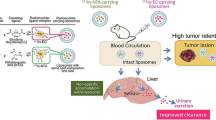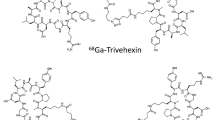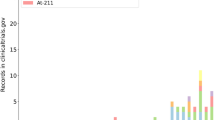Abstract
Background
Potential new radioligands for the noninvasive imaging of cardiac β-adrenoceptors with single-photon emission computed tomography were investigated.
Methods and Results
Two iodinated derivatives of CGP12177 para (S-CYBL2B) and ortho (CYBL2A) substituted CGP12177 and an iodinated form of nadolol (CYBL1) were synthesized. Their affinity was tested in vitro (left ventricular homogenates). The biodistribution of [123I]S-CYBL2B was evaluated in rabbits. Specific binding was assessed by pretreatment of the animals with 0.1 μmol propranolol. The inhibition constant values (in nanomolars, means±SEM; n=3 to 5) were determined at 1.17±0.42, 28800±9260, 11.1±2.1, 53.0±19.9, and 1790±700 for CGP12177, CYBL2A, S-CYBL2B, nadolol, and CYBL1. Myocardial uptake of [123I]S-CYBL2B was not inhibited by pretreatment of the animals with propranolol, but uptake by lung tissue could be blocked by propranolol (0.63%±0.09% vs 0.33%±0.02% % injected dose/g×kg; p<0.05). In isolated right atria, preincubation with S-CYBL2B induced a parallel rightward shift of the concentration-response curve with isoprenaline.
Conclusions
S-CYBL2B shows high affinity for cardiac β-adrenoceptors, but binding proved nonspecific in vivo, whereas binding in lung tissue was specific. These results suggest that S-CYBL2B is probably not a suitable radioligand for receptor imaging.
Similar content being viewed by others
References
Lands AM, Arnold A, McAuliff JP, Luduena FP, Brown TG. Differentiation of receptor systems activated by sympathomimetic amines. Nature 1967;214:597–8.
Baumann G, Riess G, Erhardt WD, et al., Impaired beta-adrenergic stimulation in the uninvolved ventricle post-acute myocardial infarction: reversible defect due to excessive circulation catecholamine-induced decline in number and affinity of beta-adrenoceptors. Am Heart J 1981;101:569–81.
Francis GS, Cohn JN. Heart failure: mechanisms of cardiac and vascular dysfunction and the rationale for pharmacologic intervention. FASEB J 1990;4:3068–75.
Maisel AS, Motulsky HJ, Insel PA. Externalization of beta-adrenergic receptors promoted by myocardial ischemia. Science 1985;230:183–6.
Baker SP. Effect of thyroid status on beta-adrenoceptors and muscarinic receptors in the rat lung. J Auton Pharmacol 1981;1: 269–77.
Latifpour J, McNeill JM. Cardiac autonomic receptors: effect of long-term experimental diabetes. J Pharmacol Exp Ther 1984;230: 242–9.
Kashiwagi A, Nishio Y, Saeki Y, Kida Y, Kodama M, Shigeta Y. Plasma membrane-specific deficiency in cardiac beta-adrenergic receptor in streptozocin-diabetic rats. Am J Physiol 1989;257: E127–32.
Brodde OE, Daul A, Michel MC Zerkowski HR. Importance of beta 2-adrenergic receptors in heart failure. Z Kardiol 1992; 81 (suppl):71–8.
Brodde OE, Zerkowski HR, Doetsch N, Motomura S, Khamssi M, Michel MC. Myocardial beta-adrenoceptor changes in heart failure: concomitant reduction in beta 1-and beta 2-adrenoceptor function related to the degree of heart failure in patients with mitral valve disease. J Am Coll Cardiol 1989;14:323–31.
Brodde OE. Chronic beta-1 blocker treatment and cardiac beta-2 adrenoceptor function [letter]. Am Heart J 1992;123:1727–8.
Brodde OE, Zerkowski HR, Borst HG, Maier W, Michel MC. Drug-and disease-induced changes of human cardiac beta-1 and beta-2 adrenoceptors. Eur Heart J 1989;10(suppl): 38–44.
Bristow MR, Ginsburg R, Umans V, et al. Beta-1 and beta-2 adrenergic receptor subpopulations in nonfailing and failing human ventricular myocardium: coupling of both receptor subtypes to muscle contraction and selective beta-1 receptor down-regulation in heart failure. Circ Res 1986;59:297–309.
Bristow MR, Kantrowitz NE, Ginsburg R Fowler MB. Beta-adrenergic function in heart muscle disease and heart failure. J Mol Cell Cardiol 1985;17(suppl):41–52.
Fowler MB, Laser JA, Hopkins GL, Minobe W, Bristow MR. Assessment of the beta-adrenergic receptor pathway in the intact failing human heart: progressive receptor down-regulation and subsensitivity to agonist response. Circulation 1986;74:1290–302.
Cohn JN, Levine TB, Olivari MT et al. Plasma norepinephrine as a guide to prognosis in patients with chronic congestive heart failure. N Engl J Med 1984;311:819–23.
Kosugi M, Shimizu K, Ohtani A, Migita T. Palladium catalyzed reaction of hexabutylditin with aryl bromides: preparation of negatively substituted aryltributyltin. Chem Lett 1981:829–30.
Delforge J, Syrota A, Lancon JP, et al. Cardiac beta-adrenergic receptor density measured in vivo using PET, CGP 12177, and a new graphical method. J Nucl Med 1991;32:739–48.
Merlet P, Delforge J, Syrota A, et al. Positron emission tomography with 11C CGP-12177 to assess beta-adrenergic receptor concentration in idiopathic dilated cardiomyopathy. Circulation 1993;87:1169–78.
Sibley DR, Strasser RH, Benovic JL, Daniel K, Lefkowitz RJ. Phosphorylation/dephosphorylation of the beta-adrenergic receptor regulates its functional coupling to adenylate cyclase and subcellular distribution. Proc Natl Acad Sci USA 1986;83:9408–12.
Collins S, Bouvier M, Lohse MJ, Benovic JL, Caron MG, Lefkowitz RJ. Mechanisms involved in adrenergic receptor desensitization. Biochem Soc Trans 1990;18:541–4.
Sisson JC, Wieland DM, Koeppe RA, et al., Scintigraphic portrayal of beta receptors in the heart. J Nucl Med 1991;32:1399–407.
Hillmann-Elies A, Hillmann G, Schiedt U. 2-Iodoestrone and 2-iodoestradiol. Z Naturforsch [B] 1953;8:436–40.
Janssen DE, Wilson CV. 4-Iodoveratrole. Organic Synth Coll 1963;4:457–9.
Weinstock LM, Mulvey DM, Tull R. Synthesis of the beta-adrenergic blocking agent timolol from optically active precursors. J Organic Chem 1976;41:3121–4.
Baldwin JJ, Hirschmann R, Lumma WC Jr, Ponticello GS, Sweet CS, Scriabine A. An approach to peripheral vasodilator-beta-blocking agents. J Med Chem 1977;20:1024.
Hammadi A, Crouzel C. Stereoselective synthesis of the (R)- and (S)-1-(2-amino-3-ntrophenoxy)-3-(tert-butylamino)-2-propanol from the enatiometric glycidyl tosylates. Tetrahedron Asymmetry 1990;1:579–82.
Hammadi A, Crouzel C. Asymmetric synthesis of (2S)- and (2R)-4-(3-t-butylamino-2-hydrxypropoxy)-benzimidazol-2-[11C]-one ((S) and (R)-[11C]CGP12177) from optically active precursors. J Lab Comp Radiopharm 1991;29:681–90.
Witsenboer AJ, de Goeij JJM, Reiffers S. Production of iodine-123 via proton irradiation of 99.8% enriched xenon-124. J Lab Comp Radiopharm 1986;23:1284–5.
Engel G, Hoyer D, Berthold R, Wagner H. (±)[125Iodo] cyanopindolol, a new ligand for beta-adrenoceptors: identification and quantitation of subclasses of beta-adrenoceptors in guinea pig. Naunyn Schmiedebergs Arch Pharmacol 1981;317:277–85.
Waagstein F. Beta blockers in heart failure. Cardiology 1993; 82(suppl):13–8.
Fowler MB. Controlled trials with beta blockers in heart failure: metoprolol as the prototype. Am J Cardiol 1993;71:45C-53C.
Brodde OE. Pathophysiology of the beta-adrenoceptor system in chronic heart failure: consequences for treatment with agonists, partial agonists or antagonists? Eur Heart J 1991;12(suppl):54–62.
Persson H, Erhardt L. Beta receptor antagonists in the treatment of heart failure. Cardiovasc Drugs Ther 1991;5:589–604.
Eichhorn EJ, Sobotka P. Novel approaches to congestive heart failure: use of beta-adrenergic blockade. Coronary Artery Dis 1994;5:101–6.
Brady F, Luthra SK, Tochon-Dangy HJ, et al. Asymmetric synthesis of a precursor for the automated radiosynthesis of S-(3′-t-butylamino-2′-hydroxypropoxy)-benzimidazol-2-[11C]-one (S-[11C]-CGP12177) as a preferred radioligand for beta-adrenergic receptors. Int J Radiat Appl Instrum [A] 1991;42:621–8.
Bristow MR. Changes in myocardial and vascular receptors in heart failure. J Am Coll Cardiol 1993;22:61A-71A.
Maisel AS, Phillips C, Michel MC, Ziegler MG, Carter SM. Regulation of cardiac beta-adrenergic receptors by captopril: implications for congestive heart failure. Circulation 1989;80:669–75.
Delehanty JM, Himura Y, Elam H, Hood WB Jr, Liang CS. Beta-adrenoceptor downregulation in pacing-induced heart failure is associated with increased interstitial NE content. Am J Physiol 1994;266:H930–5.
Brodde OE. Beta-adrenoceptors in cardiac disease. Pharmcol Ther 1993;60:405–30.
Steinfath M, Lavicky J, Schmitz W, Scholz H, Doring V, Kalmar P. Changes in cardiac beta-adrenoceptors in human heart diseases: relationship to the degree of heart failure and further evidence for etiology-related regulation of beta 1 and beta 2 subtypes. J Cardiothorac Vasc Anesth 1993;7:668–73.
Author information
Authors and Affiliations
Additional information
Supported by grant D92015 of the Netherlands Heart Foundation.
Rights and permissions
About this article
Cite this article
Dubois, E.A., Somsen, G.A., van den Bos, J.C. et al. Pharmacologic characterization in vitro and in vivo of iodine 123-labeled derivatives of the β-adrenoceptor antagonist CGP 12177, designed for the imaging of cardiac β-receptors. J Nucl Cardiol 3, 242–252 (1996). https://doi.org/10.1016/S1071-3581(96)90038-0
Received:
Accepted:
Issue Date:
DOI: https://doi.org/10.1016/S1071-3581(96)90038-0




